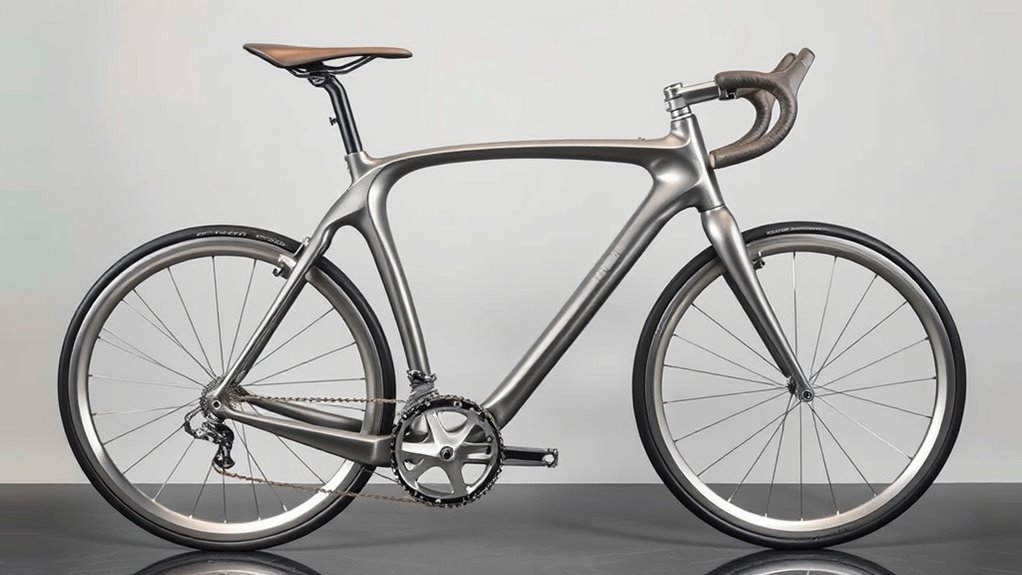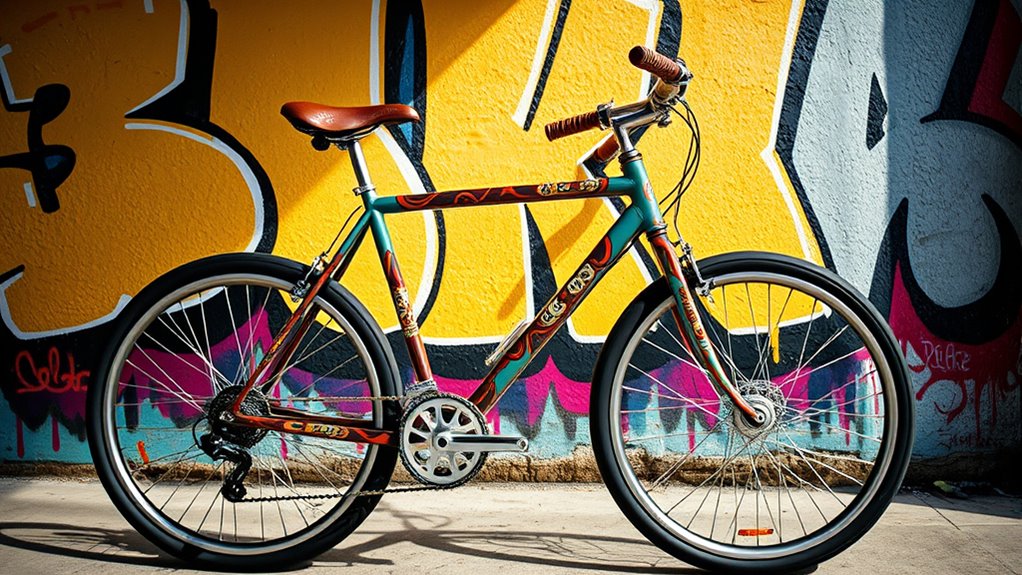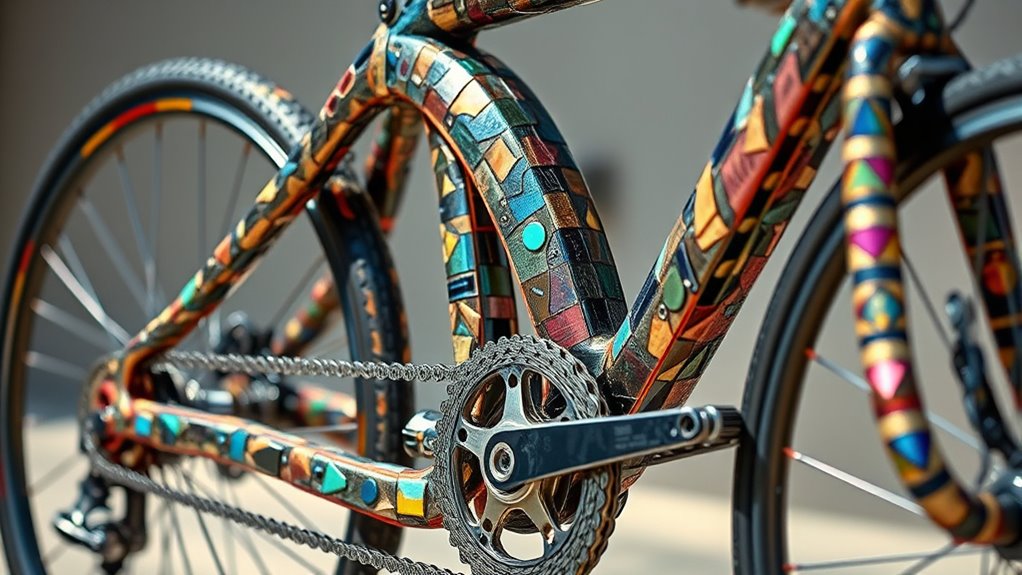Exploring bicycle design as functional art means seeing bikes as more than transportation—they’re expressions of craftsmanship, culture, and innovation. From early iron frames to modern carbon fiber and titanium, designers use materials to create unique aesthetics and performance. Personal touches like laser-etched graphics or hybrid materials turn bikes into wearable art. Recycling parts and honoring craftsmanship add cultural depth. Keep exploring, and you’ll uncover how bikes reflect societal values, creativity, and evolving technology in surprising ways.
Key Takeaways
- Bicycle design integrates aesthetics and engineering through materials like carbon fiber and titanium, creating visually striking yet functional frames.
- Customization using parametric design and advanced tools enables personalized bicycles that blend artistic expression with biomechanical optimization.
- Artists repurpose recycled parts into sculptures, transforming bicycles into sustainable art pieces that reflect cultural values and environmental messages.
- Artistic techniques such as laser etching, paint finishes, and motifs elevate bicycles from utilitarian objects to wearable art and cultural symbols.
- Community engagement through bicycle workshops, murals, and installations fosters a cultural dialogue, making bicycles a form of functional artistic expression.
The Artistic Evolution of Bicycle Frames

The artistic evolution of bicycle frames reveals a fascinating journey from functional objects to works of art. In the early days, wood gave way to metal, with Karl von Drais’s 1817 “swiftwalker” made of wood, while Michaux’s 1860s velocipede introduced iron frames and pedals. Decorative ironwork became common, blending ornamentation with industrial strength to challenge perceptions of practicality. Rigid iron frames earned the nickname “boneshaker,” prompting designers to balance aesthetics with comfort. Pierre Lallement’s work in America fused European craftsmanship with utilitarian needs, influencing high-wheel designs of the 1870s, which used curvilinear metal frames to support larger wheels while maintaining visual harmony. These early artistic influences set the foundation for bicycle frame aesthetics, marking a period where function and form became inseparably intertwined. Additionally, the integration of artistic elements in design reflects an understanding of artistic innovation to enhance both visual appeal and user experience. The evolution of materials, such as the transition from iron to lightweight alloys, further exemplifies how material science has contributed to the artistic and functional progression of bicycle design. Moreover, advances in manufacturing techniques have enabled more intricate and expressive designs, broadening the scope of artistic expression in bicycle construction. Recognizing the role of aura in influencing perceptions of design can also inspire innovative approaches to aesthetic and functional harmony.
Materials That Shape Bicycle Aesthetics and Performance

Choosing the right materials for a bicycle frame considerably influences both its aesthetic appeal and performance. Carbon fiber offers a sleek, modern look with customizable shapes and finishes, perfect for aerodynamic designs and glossy or matte surfaces. Titanium provides a metallic sheen, often unpainted, emphasizing industrial minimalism while resisting corrosion. Aluminum features vibrant anodized finishes and smooth welds, giving a modern appearance. Steel frames showcase classic slender tubes, visible brazing, and matte or painted finishes, evoking retro charm. Hybrid frames combine contrasting textures like carbon forks on steel structures, blending style and function. Each material has performance trade-offs: carbon fiber is lightweight and stiff but brittle; titanium is durable and comfortable but costly; aluminum is affordable but transmits road vibrations; steel offers a smooth ride but is heavier and rust-prone. Understanding IRA investing can help you make informed decisions about alternative assets that enhance your portfolio.
Personalization and Creativity in Custom Bicycle Design

Personalization and creativity transform bicycle design from mere transportation to a form of self-expression and innovation. You can tailor frames with parametric designs that adjust geometry for your biomechanics and aerodynamics. Using carbon fiber allows lightweight yet durable builds with complex shapes, while tubing modifications like adjustable steering and reinforced stays enhance performance. 3D-printed titanium lugs enable joint customization and hybrid material integration. Modular systems let you swap components for different disciplines. Aerodynamic features such as deep-section wheels and integrated cockpits improve airflow and stability. You can also personalize performance with drivetrain upgrades, ergonomic contact points, and tire clearance options. Artistic expression flourishes through chameleon paint, laser-etched graphics, and themed motifs. Cutting-edge tools like AR apps and AI-driven patterns make your bike uniquely yours, blending function with artistry. Additionally, understanding resources and tools available, such as specialized local attorneys or design software, can support your creative and practical endeavors. Incorporating design optimization techniques ensures that your custom bicycle not only looks stunning but also performs at its peak efficiency. Exploring advanced manufacturing methods, like 3D printing and CNC machining, can further elevate your customization options. Recognizing how ear wax odor can vary may inspire innovative ventilation designs to improve rider comfort. Exploring vetted Halloween product reviews can also inspire creative themes for custom paint jobs or accessories, enhancing your bike’s personality.
Recycled Bicycles: Art From Discarded Parts

Recycled bicycles transform discarded parts into striking works of art that highlight both creativity and sustainability. You’ll see artists repurpose old bike components into sculptures and installations, giving waste a new purpose. Using materials like tires, chains, and cassettes, they create pieces that communicate environmental messages while showcasing craftsmanship. Cindy Chinn’s “Re-Tired” collection exemplifies intricate sculptures from old bike parts, emphasizing waste reduction and reuse. Artists like Drew Evans produce innovative, shareable artworks online, often blending functionality with art. These creations not only reduce landfill waste but also promote eco-consciousness. Incorporating visualization and affirmations can inspire artists to imagine new possibilities for waste reuse and innovation in their work. Through precise techniques and experimentation, recycled bike art pushes boundaries, inspiring viewers to rethink waste and sustainability. Understanding recycling practices can further enhance the impact of recycled bicycle art on environmental awareness. Moreover, engaging with design principles can help artists create more cohesive and meaningful pieces. Exploring community engagement can foster greater awareness and appreciation for sustainable art practices, encouraging broader participation. Additionally, integrating cost of living adjustments in creative projects can help artists plan sustainable and financially viable art initiatives. As this art gains recognition, it fosters community engagement and supports a shift toward greener artistic practices.
The Cultural Significance of Artistic Bicycle Craftsmanship

Throughout history, bicycles have served as more than just transportation; they’ve become powerful symbols of cultural identity and artistic expression.
Bicycles transcend utility, becoming enduring symbols of cultural identity and artistic exploration.
You recognize vintage high-wheel bikes as artifacts of 19th-century design, reflecting craftsmanship and innovation. Literary works by Mark Twain and H.G. Wells embed bicycles into cultural narratives, while murals like Mona Caron’s merge public art with cycling advocacy.
Collectors restore antique bikes to honor artisans’ skill, and handmade models mirror traditional artisan practices that balance beauty with function. Custom frames express rider identity through design choices, and workshops on the West Coast lead handmade bike culture. Additionally, the attention paid to details in handcrafted bicycles demonstrates how full focus enhances creative craftsmanship.
Bicycles symbolize social themes—class, gender, and national identity—while installations by artists like Ai Weiwei critique industrialization. This craftsmanship elevates bicycles from tools to powerful cultural symbols. Increased digital literacy programs among seniors also foster playful and humorous communication, reflecting the multifaceted cultural significance of bicycles and their related cultural practices.
Furthermore, the rise of artistic bicycle design as a form of creative expression highlights how bikes continue to inspire innovation and cultural dialogue. Recent advancements in technological integration, such as smart bicycles, demonstrate the evolving relationship between art and technology in cycling culture.
Frequently Asked Questions
How Do Innovative Bicycle Designs Influence Urban Cycling Culture?
Innovative bicycle designs shape your urban cycling culture by making bikes more attractive and functional. When bikes look good and are easy to use, you’ll be more motivated to ride, fostering a community of cyclists.
These designs also encourage cities to build better infrastructure, reduce traffic, and promote sustainability. As a result, your city becomes more vibrant, healthier, and eco-friendly, creating an inviting environment for everyone to embrace cycling.
What Are the Environmental Benefits of Using Sustainable Materials in Bike Art?
Using sustainable materials in bike art offers numerous environmental benefits. You help reduce CO₂ emissions by choosing recycled or regionally sourced materials, which lower transportation impacts.
These materials are often renewable, durable, and recyclable, extending their lifespan and minimizing waste. Additionally, natural options like wood sequester carbon, and eco-friendly finishes decrease pollution.
Can Artistic Bicycle Frames Improve Riding Performance?
You might wonder if artistic bicycle frames can boost your riding performance. They can, by optimizing aerodynamics with sleek, integrated shapes or enhancing comfort through carefully chosen materials like carbon fiber or titanium.
Custom designs can also improve handling, stability, and ride quality. When art and engineering combine thoughtfully, your bike becomes not just a visual statement but a more efficient, responsive, and enjoyable ride.
How Does Cultural Context Shape Bicycle Artistic Expressions Worldwide?
Cultural context shapes bicycle artistic expressions by reflecting local values, traditions, and societal symbols. You’ll notice Dutch bikes embody egalitarianism with practical accessories, while Japanese bikes often feature festive decorations for festivals.
In Burning Man, bikes become sculptures with LED lights and kinetic art. These cultural influences inspire you to see bicycles not just as transport, but as meaningful symbols that celebrate community, history, and creative identity worldwide.
What Role Does Technology Play in Modern Custom Bicycle Craftsmanship?
Technology plays an essential role in modern custom bicycle craftsmanship by enabling precise, innovative designs.
You can use materials like titanium, carbon fiber, and advanced metals, which improve strength and reduce weight.
Techniques such as 3D printing, CNC machining, and modern welding allow you to create highly customized, complex components and frames.
These advancements give you the freedom to craft bikes that aren’t only functional but also visually striking, pushing creative boundaries.
Conclusion
As you imagine the next ride, picture a bicycle that’s more than just transportation—it’s a canvas waiting to be explored. From shimmering recycled parts to bold custom designs, each frame tells a story. The line between function and art blurs, hinting at endless possibilities. Will your next bicycle become a masterpiece, blending creativity with purpose? The future of bicycle design invites you to ride into a world where art and motion collide, leaving you enthusiastic to discover what’s next.









